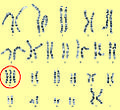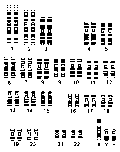Polysomy
Polysomy is a condition in which an organism has more than two copies of any one of its chromosomes. This can occur in any organism that has a diploid number of chromosomes. Polysomy is a type of aneuploidy, which is a broad category of chromosome abnormalities.
Causes[edit]
Polysomy can be caused by a variety of factors, including errors in meiosis, the process by which sex cells divide. During meiosis, chromosomes are supposed to separate so that each new cell has one copy of each chromosome. However, if the chromosomes do not separate properly, a condition known as nondisjunction, one cell may end up with extra chromosomes, leading to polysomy.
Types[edit]
There are several types of polysomy, including trisomy, in which there are three copies of a particular chromosome, and tetrasomy, in which there are four copies. The most well-known type of trisomy is Down syndrome, also known as trisomy 21, in which individuals have three copies of chromosome 21.
Symptoms and Diagnosis[edit]
The symptoms of polysomy can vary widely, depending on which chromosome is affected and how many extra copies there are. Some forms of polysomy can lead to physical abnormalities, intellectual disabilities, and other health problems. Polysomy can be diagnosed through a variety of tests, including karyotyping, in which the chromosomes in a person's cells are examined under a microscope, and genetic testing, which can identify specific genetic abnormalities.
Treatment[edit]
There is currently no cure for polysomy, and treatment typically focuses on managing symptoms and improving quality of life. This can include physical therapy, occupational therapy, and other interventions to help individuals with polysomy reach their full potential.
See also[edit]
Ad. Transform your life with W8MD's Budget GLP-1 injections from $75


W8MD offers a medical weight loss program to lose weight in Philadelphia. Our physician-supervised medical weight loss provides:
- Weight loss injections in NYC (generic and brand names):
- Zepbound / Mounjaro, Wegovy / Ozempic, Saxenda
- Most insurances accepted or discounted self-pay rates. We will obtain insurance prior authorizations if needed.
- Generic GLP1 weight loss injections from $75 for the starting dose.
- Also offer prescription weight loss medications including Phentermine, Qsymia, Diethylpropion, Contrave etc.
NYC weight loss doctor appointmentsNYC weight loss doctor appointments
Start your NYC weight loss journey today at our NYC medical weight loss and Philadelphia medical weight loss clinics.
- Call 718-946-5500 to lose weight in NYC or for medical weight loss in Philadelphia 215-676-2334.
- Tags:NYC medical weight loss, Philadelphia lose weight Zepbound NYC, Budget GLP1 weight loss injections, Wegovy Philadelphia, Wegovy NYC, Philadelphia medical weight loss, Brookly weight loss and Wegovy NYC
|
WikiMD's Wellness Encyclopedia |
| Let Food Be Thy Medicine Medicine Thy Food - Hippocrates |
Medical Disclaimer: WikiMD is not a substitute for professional medical advice. The information on WikiMD is provided as an information resource only, may be incorrect, outdated or misleading, and is not to be used or relied on for any diagnostic or treatment purposes. Please consult your health care provider before making any healthcare decisions or for guidance about a specific medical condition. WikiMD expressly disclaims responsibility, and shall have no liability, for any damages, loss, injury, or liability whatsoever suffered as a result of your reliance on the information contained in this site. By visiting this site you agree to the foregoing terms and conditions, which may from time to time be changed or supplemented by WikiMD. If you do not agree to the foregoing terms and conditions, you should not enter or use this site. See full disclaimer.
Credits:Most images are courtesy of Wikimedia commons, and templates, categories Wikipedia, licensed under CC BY SA or similar.
Translate this page: - East Asian
中文,
日本,
한국어,
South Asian
हिन्दी,
தமிழ்,
తెలుగు,
Urdu,
ಕನ್ನಡ,
Southeast Asian
Indonesian,
Vietnamese,
Thai,
မြန်မာဘာသာ,
বাংলা
European
español,
Deutsch,
français,
Greek,
português do Brasil,
polski,
română,
русский,
Nederlands,
norsk,
svenska,
suomi,
Italian
Middle Eastern & African
عربى,
Turkish,
Persian,
Hebrew,
Afrikaans,
isiZulu,
Kiswahili,
Other
Bulgarian,
Hungarian,
Czech,
Swedish,
മലയാളം,
मराठी,
ਪੰਜਾਬੀ,
ગુજરાતી,
Portuguese,
Ukrainian











